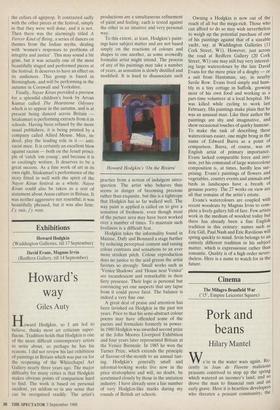Exhibitions
Howard Hodgkin (Waddington Galleries, till 17 September) David Evans, Magnus Irvin (Redfern Gallery, till 14 September)
Howard's way
Giles Auty
Howard Hodgkin, so I am led to believe, thinks most art criticism super- fluous. Tradition holds that Hodgkin is one of the more difficult contemporary artists to write about, so perhaps he has his reasons. I did not review his last exhibition of paintings in Britain which was put on for the reopening of the Whitechapel Art Gallery nearly three years ago. The major difficulty for many critics is that Hodgkin makes obvious points of comparison hard to find. The work is based on personal incident, yet seldom so in any sense that can be recognised readily. The artist's
productions are a simultaneous refinement of paint and feeling; each is tested against the other in an intuitive and very personal way.
To this extent, at least, Hodgkin's paint- ings have subject matter and are not based simply on the reactions of colours and shapes to one another, as some avowedly formalist artist might intend. The process of any of his paintings may take a number of years, as sensation is slowly distilled and modified. It is hard to disassociate such practice from a notion of indulgent intro- spection. The artist who behaves thus seems in danger of becoming precious rather than exquisite, but this is a tightrope that Hodgkin has so far walked well. The way paint is applied is called on to give a sensation of freshness, even though most of the picture area may have been worked over a number of times. To maintain such liveliness is a difficult feat.
Hodgkin takes the informality found in Matisse, Dufy and Bonnard a stage further by reducing perceptual content and raising colour contrasts and sensations to an ever more strident pitch. Colour reproduction does no justice to the acid greens the artist favours so strongly. Small works such as 'Venice Shadows' and 'House near Venice' are incandescent and remarkable in their fiery presence. Their logic is personal but convincing yet one suspects that any lapse from it could prove fatal. The balance is indeed a very fine one.
A great deal of praise and attention has been lavished on Hodgkin in the past ten years. Prior to that his semi-abstract colour poems may have offended some of the purists and formalists formerly in power. In 1980 Hodgkin was awarded second prize at the John Moores Liverpool Exhibition and four years later represented Britain at the Venice Biennale. In 1985 he won the Turner Prize, which extends the principle of flavour-of-the-month to an annual tast- ing. Hodgkin's generally small and informal-looking works live now in the price stratosphere and will, no doubt, be scrutinised closely by those in the imitation industry. I have already seen a fair number of very Hodgkin-like marks during my rounds of British art schools. Howard Hodgkin's 'On the Riviera'
Owning a Hodgkin is now out of the reach of all but the mega-rich. Those who can afford to do so may wish nevertheless to weigh up the potential purchase of one of his paintings against that of a sizeable yacht, say, at Waddington Galleries (11 Cork Street, W1). However, just across the road at Redfern Gallery (20 Cork Street, W1) one may still buy very interest- ing large watercolours by the late David Evans for the mere price of a dinghy — or a suit from Huntsman, say, in nearby Savile Row. Evans lived simply and hum- bly in a tiny cottage in Suffolk, growing most of his own food and working as a part-time volunteer at a local hospital. He was killed while cycling to work last February. His paintings make plain that he was an unusual man. Like their author the paintings are shy and imaginative, and show occasional touches of quirky humour. To make the task of describing these watercolours easier, one might bring in the name of Edward Burra as a point of comparison. Burra, of course, was an English artist of primary importance. Evans lacked comparable force and inci- sion, yet his command of large watercolour composition is, at times, hardly less sur- prising. Evans's paintings of flowers and vegetables, country events and animals and birds in landscapes have a breath of genuine poetry. The 27 works on view are all that remains of the artist's estate.
Evans's watercolours are coupled with recent woodcuts by Magnus Irvin to com- plete a lively gallery bill of fare. Few artists work in the medium of woodcut today but there has already been a fine English tradition in this century: names such as Eric Gill, Paul Nash and Eric Ravilious will spring quickly to mind. Irvin belongs to an entirely different tradition in his subject matter, which is expressionist rather than romantic. Quality is of a high order never- theless. Here is a name to watch for in the future.










































 Previous page
Previous page